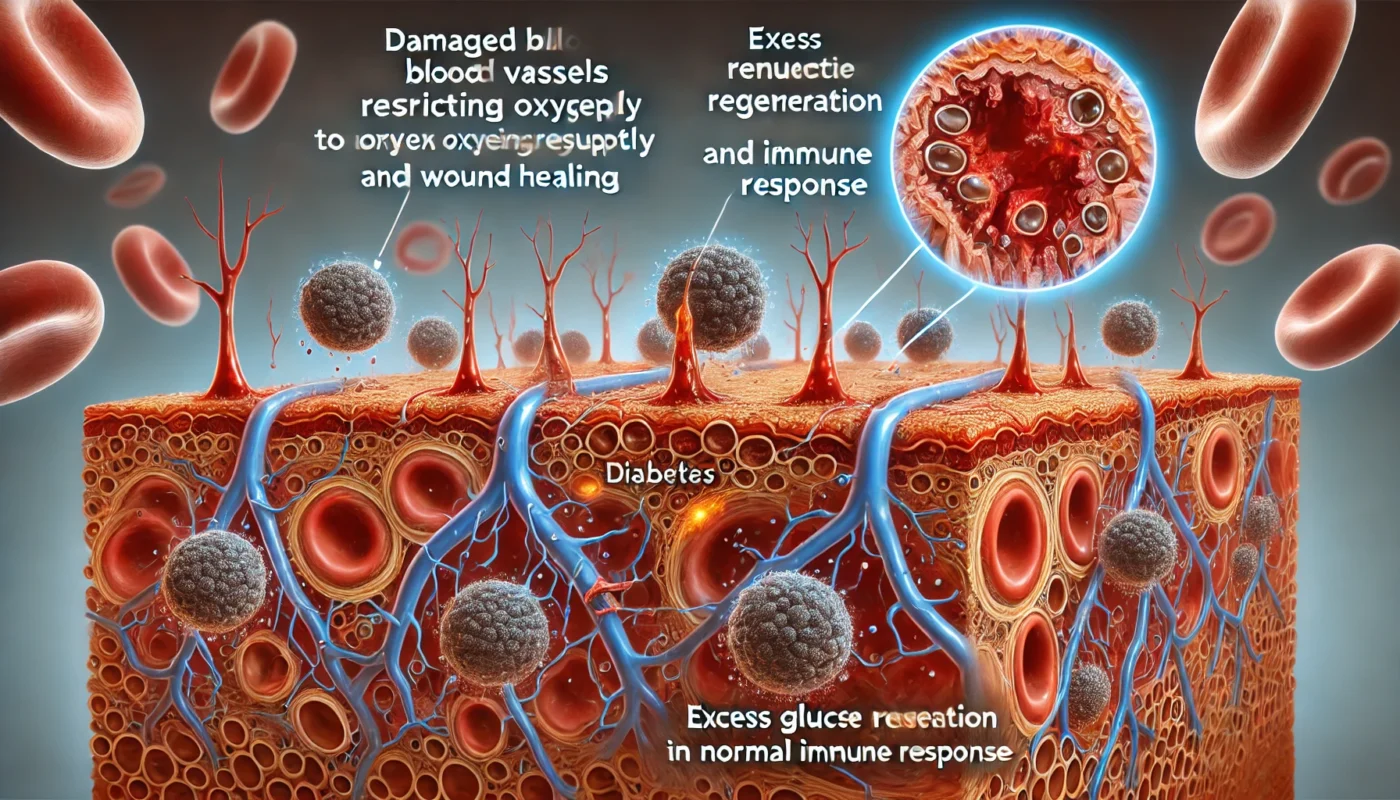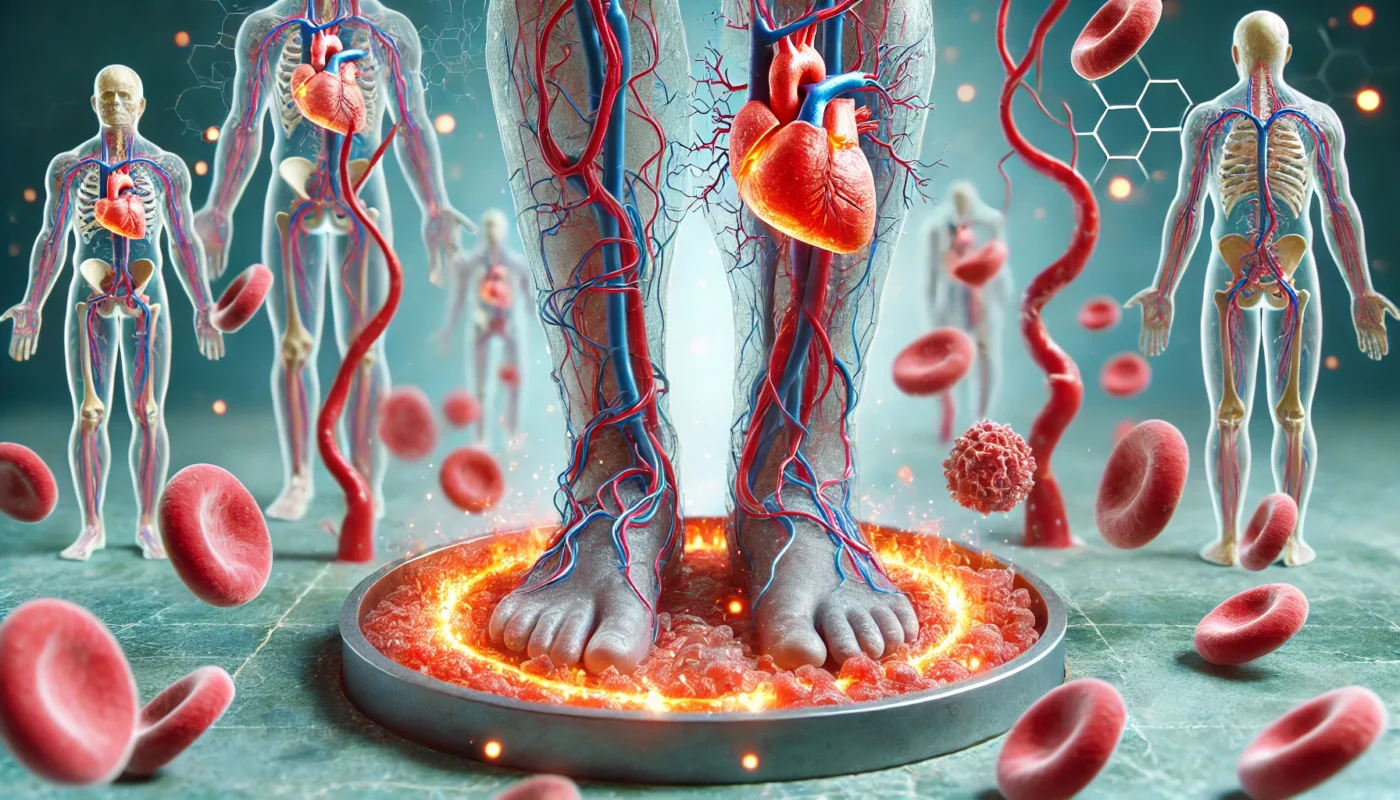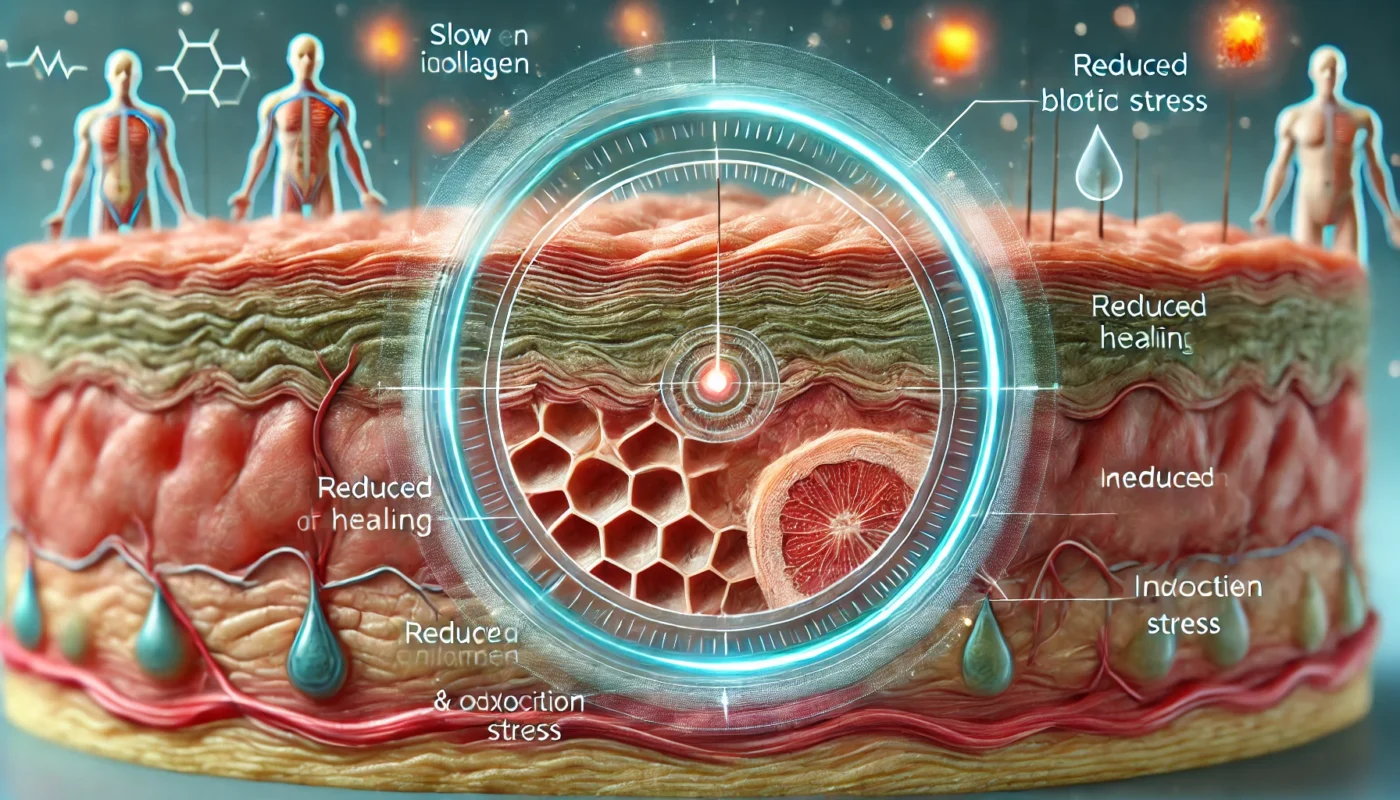Wound healing is a complex physiological process involving multiple stages: hemostasis, inflammation, proliferation, and remodeling. Each phase is critical and interdependent, requiring a well-coordinated effort from various cells, growth factors, and enzymes. When any of these components are disrupted, impaired wound healing can occur.
You may also like: Top Nutrients for Faster Wound Recovery
Hemostasis
Hemostasis is the initial response to injury, crucial for preventing excessive blood loss. It involves blood vessel constriction and the formation of a clot that acts as a barrier against pathogens. Platelets play a vital role in this phase, releasing factors that initiate the subsequent inflammatory process. Any disruption in this phase, such as clotting disorders, can significantly delay healing.
Inflammation
The inflammation phase is characterized by the recruitment of immune cells to the wound site, which helps clear debris and pathogens. This response is essential for preparing the wound bed for healing. However, chronic inflammation, often resulting from persistent infections or underlying health conditions, can impede wound closure and prolong recovery.
Proliferation
During the proliferation stage, new tissue forms to cover the wound. Fibroblasts, collagen deposition, and angiogenesis are key components of this phase, promoting the development of new blood vessels and tissue. Factors such as nutritional deficiencies or inadequate blood supply can hinder this stage, resulting in delayed healing.
Remodeling
The remodeling phase, the final step in wound healing, involves the maturation and strengthening of new tissue. Collagen fibers are reorganized to enhance tensile strength and elasticity. Compromised remodeling, due to factors like poor nutrition or persistent inflammation, can lead to weaker scar tissue and increased risk of re-injury.

Factors That Impede Wound Healing
Numerous factors can hinder the wound healing process. Understanding these can help you mitigate their effects and promote faster recovery.
Poor Nutrition
Nutrition plays a pivotal role in wound healing. Deficiencies in essential nutrients, such as vitamins A, C, and E, zinc, and protein, can significantly delay healing. These nutrients are vital for collagen synthesis, immune function, and cellular repair.
Importance of Micronutrients
Micronutrients like vitamins and minerals are crucial for cellular processes. Vitamin C, for example, is essential for collagen synthesis, while zinc supports immune function and cell membrane integrity. A lack of these nutrients can result in a weakened immune response and slower tissue repair.
Protein’s Role
Proteins are the building blocks of tissues and are necessary for the synthesis of new cells and enzymes. Amino acids, particularly arginine and glutamine, play a critical role in immune function and collagen formation. Ensuring adequate protein intake is vital for a robust healing process.
Implementing a Balanced Diet
A balanced diet that includes a variety of fruits, vegetables, lean proteins, and whole grains can provide the necessary nutrients for optimal healing. Consider consulting a nutritionist to tailor a diet that meets your specific healing needs and addresses any deficiencies.
Insufficient Oxygenation
Adequate oxygen supply is crucial for cellular metabolism and energy production, both of which are essential for wound repair. Conditions such as anemia or chronic obstructive pulmonary disease (COPD) can impair oxygen delivery to tissues, thus delaying healing.
Role of Oxygen in Healing
Oxygen is necessary for the production of energy in cells, which is required for various metabolic processes involved in healing. It also supports the immune response and helps in the synthesis of collagen, essential for tissue repair.
Conditions Affecting Oxygenation
Chronic conditions like COPD or heart disease can reduce oxygen delivery to tissues. Anemia, characterized by low levels of hemoglobin, can also impair oxygen transport, affecting healing outcomes. Identifying and managing these conditions is crucial for improving wound healing.
Strategies to Enhance Oxygenation
Improving oxygen delivery can be achieved through lifestyle changes and medical interventions. Breathing exercises, supplemental oxygen therapy, or medications that improve cardiovascular function can enhance oxygenation. Regular physical activity can also improve overall cardiovascular health, promoting better oxygen delivery.
Infection
Infections can severely impede wound healing by prolonging the inflammatory phase and damaging tissue. Maintaining proper wound hygiene, using antiseptics, and seeking medical treatment for signs of infection are vital steps in preventing and managing infections.
For individuals with diabetes, wound infections can be particularly challenging, often leading to severe complications if not managed properly. Understanding how diabetes affects wound healing can help in adopting effective prevention and treatment strategies.
Identifying Signs of Infection
Early detection of infection is crucial for effective management. Signs include increased redness, swelling, warmth, and discharge from the wound. Fever and pain may also indicate an infection that requires medical attention.
Preventive Measures
Prevention is key to managing wound infections. Keeping the wound clean and covered, changing dressings regularly, and avoiding contact with contaminated surfaces can reduce infection risk. Antiseptic solutions can further help in maintaining a sterile environment.
Treatment Options
If an infection is present, medical treatment is essential. Antibiotics may be prescribed to combat bacterial infections, while antifungal or antiviral medications may be necessary for other types of infections. Early intervention can prevent complications and promote healing.
Chronic Diseases
Chronic illnesses, such as diabetes, vascular diseases, and autoimmune conditions, can adversely affect wound healing. Diabetes, for example, can lead to neuropathy and poor circulation, both of which impair healing.
Impact of Diabetes
Diabetes can lead to high blood sugar levels, which impair immune function and reduce circulation. Neuropathy, a common complication, can result in loss of sensation, increasing the risk of unnoticed injuries and infections.
Vascular and Autoimmune Disorders
Vascular diseases can impair blood flow to the wound site, while autoimmune conditions can result in chronic inflammation, both of which delay healing. Managing these conditions through medication and lifestyle changes is essential for promoting wound recovery.
Management Strategies
Effective management of chronic diseases involves regular monitoring, medication adherence, and lifestyle modifications. Blood sugar control, blood pressure management, and regular check-ups can enhance healing outcomes and prevent complications.
Medications
Certain medications, including corticosteroids and nonsteroidal anti-inflammatory drugs (NSAIDs), can delay wound healing by inhibiting the inflammatory response or collagen synthesis. If you suspect your medication might be affecting your healing process, consult your healthcare provider for potential alternatives.
Corticosteroids and Healing
Corticosteroids are commonly used to reduce inflammation but can impair wound healing by suppressing immune function and collagen production. Their use should be closely monitored, especially in individuals with wounds.
NSAIDs and Their Effects
NSAIDs, often used for pain relief, can interfere with the inflammatory process necessary for healing. They may inhibit the synthesis of prostaglandins, which play a role in wound repair. Consulting a healthcare provider about alternative pain management strategies is advisable.
Exploring Alternatives
If medication is affecting wound healing, alternative treatments may be considered. These can include physical therapy, acupuncture, or herbal remedies known to support healing. Always discuss options with a healthcare professional to ensure safety and efficacy.
Stress and Psychological Factors
Psychological stress can negatively impact wound healing by altering immune function and increasing levels of stress hormones, such as cortisol. Practices such as mindfulness, meditation, and stress management techniques can help mitigate these effects and support healing.
The Link Between Stress and Healing
Stress triggers the release of cortisol, which can suppress the immune response and prolong inflammation. Chronic stress can also affect sleep and nutrition, indirectly impacting healing.
Mindfulness and Meditation
Mindfulness and meditation practices can reduce stress and promote relaxation. These techniques can help lower cortisol levels, enhance immune function, and improve overall well-being, supporting the healing process.
Stress Management Techniques
Incorporating stress management techniques into daily routines can have a positive impact on healing. Exercise, deep breathing, and hobbies that promote relaxation can reduce stress and improve recovery outcomes.

External Factors Affecting Wound Healing
Beyond physiological factors, external elements can also play a significant role in wound healing.
Environmental Conditions
Temperature and humidity can influence wound healing. Extreme temperatures can disrupt cellular functions, while dry environments can lead to dehydration of the wound bed. Maintaining an optimal environment with proper moisture balance can aid in the healing process. Learn more practical tips for soothing irritated skin and creating an optimal healing environment.
Impact of Temperature
Both high and low temperatures can affect wound healing. Cold environments may reduce blood flow, while excessive heat can increase the risk of infection. Maintaining a stable temperature around the wound is essential for optimal healing.
Role of Humidity
Humidity levels can impact wound hydration. Low humidity can lead to drying of the wound bed, while excessive moisture can increase the risk of bacterial growth. Using appropriate dressings to maintain a balanced moisture environment is crucial.
Creating an Ideal Healing Environment
Creating a controlled environment that supports healing involves managing both temperature and humidity. Air conditioning, humidifiers, or dehumidifiers can help maintain optimal conditions, facilitating better wound outcomes.
Smoking and Alcohol Consumption
Both smoking and excessive alcohol consumption can impair wound healing. Smoking reduces blood flow and oxygen delivery, while alcohol can affect immune response and nutrient absorption. Reducing or eliminating these habits can have a profound positive impact on wound recovery. Discover more about the specific ways smoking impacts wound healing and why quitting can greatly enhance recovery outcomes.
Effects of Smoking
Smoking constricts blood vessels, reducing oxygen and nutrient delivery to the wound site. It also introduces toxins that can delay healing and increase infection risk. Quitting smoking can significantly enhance the body’s healing capacity.
Alcohol’s Impact on Healing
Excessive alcohol intake can impair liver function and nutrient absorption, both of which are vital for wound repair. Alcohol can also weaken immune function, making the body more susceptible to infections.
Steps to Reduce Consumption
Reducing or eliminating smoking and alcohol consumption can improve overall health and wound healing. Support groups, counseling, and medical interventions can assist in managing these habits and promoting recovery.
Mechanical Stress and Pressure
Constant pressure or mechanical stress on a wound can disrupt the healing process. Ensuring proper wound protection and using pressure-relieving devices, especially for pressure ulcers, can mitigate these effects.
Understanding Mechanical Stress
Mechanical stress can result from friction, pressure, or repetitive movements that disrupt the wound bed. This can lead to further tissue damage and delayed healing.
Pressure Ulcers and Prevention
Pressure ulcers, or bedsores, result from prolonged pressure on the skin. Regular repositioning, specialized mattresses, and pressure-relieving cushions can prevent these ulcers and support healing.
Protective Measures
Using protective dressings and avoiding unnecessary movement can minimize mechanical stress on wounds. Ensuring a comfortable and supportive environment is essential for optimal healing.
Strategies to Promote Wound Healing
While understanding factors that delay healing is essential, employing strategies to promote recovery is equally important.
Adequate Hydration
Hydration is crucial for maintaining skin elasticity and facilitating cellular functions. Ensuring adequate fluid intake supports the wound healing process and overall health.
Role of Water in Healing
Water is essential for maintaining cell structure and function. It supports nutrient transport, waste removal, and cellular communication, all critical for wound repair.
Recommended Fluid Intake
The recommended daily fluid intake varies based on age, gender, and activity level. Generally, consuming at least eight glasses of water a day can support hydration and healing.
Hydration Strategies
Incorporating hydration strategies, such as carrying a water bottle, consuming water-rich foods, and setting reminders, can help maintain adequate fluid intake and promote healing.
Regular Exercise
Engaging in regular physical activity can improve circulation, enhance immune function, and promote overall well-being. However, it’s important to tailor exercise regimens to your individual healing stage and capabilities.
Benefits of Exercise
Exercise enhances cardiovascular health, promoting better oxygen and nutrient delivery to tissues. It also boosts immune function and reduces stress, both of which support healing.
Tailoring Exercise to Healing
Exercise regimens should be tailored to the individual’s healing stage and capabilities. Low-impact activities like walking or swimming can promote circulation without causing additional stress on the wound.
Incorporating Physical Activity
Incorporating regular physical activity into daily routines can support overall health and healing. Consulting a physical therapist or healthcare provider can help design a safe and effective exercise plan.
Holistic and Alternative Approaches
Incorporating holistic and alternative practices, such as acupuncture, herbal supplements, or essential oils, can complement traditional medical treatments and support the healing process.
Exploring Holistic Practices
Holistic practices, such as yoga and tai chi, can promote relaxation and improve circulation. These practices can be integrated into daily routines to support overall well-being and healing.
Herbal Supplements
Herbal supplements like aloe vera, turmeric, and honey have been used for centuries to promote healing. They can be used topically or orally, but it’s important to consult a healthcare provider before use.
Use of Essential Oils
Essential oils, such as lavender and tea tree oil, possess antimicrobial and anti-inflammatory properties. They can be applied topically to support healing, but should be used with caution to prevent irritation.
Monitoring and Professional Care
Regular monitoring of wounds and seeking professional medical advice when necessary is crucial. Healthcare professionals can provide tailored treatments and interventions to address specific healing challenges.
Importance of Regular Monitoring
Regular monitoring allows for early detection of complications, such as infection or delayed healing. This can lead to timely interventions and improved outcomes.
Seeking Professional Advice
Professional healthcare providers can offer expert guidance on wound care and treatment options. They can tailor interventions to address specific challenges and promote optimal healing.
Tailored Treatments and Interventions
Tailored treatments, such as advanced wound dressings or surgical interventions, can address specific healing challenges. Consulting a healthcare provider ensures that you receive the most appropriate care for your needs.

Conclusion
Understanding the factors that delay wound healing and employing strategies to counteract them can significantly enhance recovery and overall health. By adopting a holistic approach that combines nutrition, lifestyle changes, and professional guidance, you can optimize your body’s natural healing capabilities. Whether you’re a fitness enthusiast, a health enthusiast, or managing medical conditions, these insights and strategies can empower you on your journey to better health and well-being.
Remember, while this guide provides valuable information, it’s always important to consult healthcare professionals for personalized advice and treatment. Prioritize your health by being proactive and informed about the factors that impact your healing process.
Further Reading:
7 factors that affect wound healing
7 Factors that Affect Wound Healing
Factors That Impair Wound Healing
wound healing, smoking cessation, alcohol effects, hydration, exercise, mechanical stress, pressure ulcers, holistic approaches, herbal supplements, essential oils, professional care, nutrition, recovery strategies, health and wellness
Important Note: The information contained in this article is for general informational purposes only, and should not be construed as health or medical advice, nor is it intended to diagnose, prevent, treat, or cure any disease or health condition. Before embarking on any diet, fitness regimen, or program of nutritional supplementation, it is advisable to consult your healthcare professional in order to determine its safety and probable efficacy in terms of your individual state of health.
Regarding Nutritional Supplements Or Other Non-Prescription Health Products: If any nutritional supplements or other non-prescription health products are mentioned in the foregoing article, any claims or statements made about them have not been evaluated by the U.S. Food and Drug Administration, and such nutritional supplements or other health products are not intended to diagnose, treat, cure, or prevent any disease.

